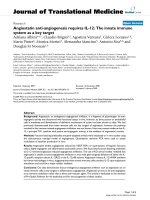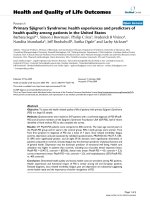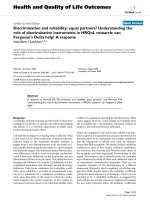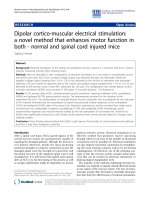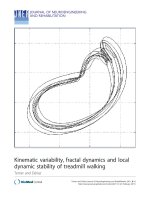báo cáo hóa học:" Serous papillary adenocarcinoma possibly related to the presence of primitive oocyte-like cells in the adult ovarian surface epithelium: a case report" docx
Bạn đang xem bản rút gọn của tài liệu. Xem và tải ngay bản đầy đủ của tài liệu tại đây (3.48 MB, 5 trang )
CAS E REP O R T Open Access
Serous papillary adenocarcinoma possibly related
to the presence of primitive oocyte-like cells in
the adult ovarian surface epithelium: a case
report
Irma Virant-Klun
1*
, Thomas Skutella
2
, Branko Cvjeticanin
1
, Martin Stimpfel
1
and Jasna Sinkovec
1
Abstract
Introduction: The presence of oocytes in the ovarian surface epithelium has already been confirmed in the fetal
ovaries. We report the presence of SSEA-4, SOX-2, VASA and ZP2-positive primitive oocyte-like cells in the adult
ovarian surface epithelium of a patient with serous papillary adenocarcinoma.
Case presentation: Ovarian tissue was surgically retrieved from a 67-year old patient. Histological analysis revealed
serous papillary adenocarcinoma. A proportion of ovarian cortex sections was deparaffinized and
immunohistochemically stained for the expression of markers of pluripotency SSEA-4 and SOX-2 and oocyte-
specific markers VASA and ZP2. The analysis confirmed the presence of round, SSEA-4, SOX-2, VASA and ZP2-
positive primitive oocyte-like cells in the ovarian surface epithelium. These cells were possibly related to the
necrotic malignant tissue.
Conclusion: Primitive oocyte-like cells present in the adult ovarian surface epithelium persisting probably from the
fetal period of life or developed from putative stem cells are a pathological condition which is not observed in
healthy adult ovaries, and might be related to serous papillary adenocarcinoma manifestation in the adult ovarian
surface epithelium. This observation needs attention to be further investigated.
Keywords: human, oocytes, ovarian surface epithelium, serous adenocarcinoma
Introduction
In fetal ovaries, the number of germ cells reaches a peak
of ~6 to 7 million during the fifth month post-fertiliza-
tion [1], after which germ cell reduction occurs during
prenatal development, resulting in the presence of only
1 million of female germ cells before birth. Two
mechanisms have been proposed to restrict the pool of
female gametes during prenatal life: 1) germ cell degen-
eration inside the developing ovary and, 2) germ cell
extension into the ovarian surface epithelium and exfo-
liation from the ov arian surface into th e coelomic cavity
[1-7]. Therefore, primitive oocytes can be found in the
ovarian surface epithelium and on the surface of fetal
ovaries, as revealed by the t ransmission and scanning
electron microscopy. Germ cells may reach the site of
ovarian surface epithelium by still retained amoeboid
movements in early developmental stages, or are pas-
sively pushed there by the morphogenetic rearrange-
ment of somat ic cells in later stages of ovarian
development. This phenomenon is observed in human
fetal ovaries, might persist until the puberty, but is not
present in adult ovaries. It has already been proposed
that these residual primitive oocytes in the adult ovarian
surface epithelium may give rise to abnormal cell
growth, such as teratomas [1,2], but not much experi-
mental evidence has been available.
Recent findings have confirmed the presence of puta-
tive stem cells in the adult human ovarian surface
epithelium [8-10]; they can also be found in the ovaries
of older women [9,11]. Putative stem cells are small
* Correspondence:
1
Department of Obstetrics and Gynecology, University Medical Centre
Ljubljana, Slovenia
Full list of author information is available at the end of the article
Virant-Klun et al. Journal of Ovarian Research 2011, 4:13
/>© 2011 Virant-Klun et al; licensee BioMed Central Ltd. This is an Open Access article distributed under the terms of the Creative
Commons Attribution License ( which permits unrestricted use, di stribution, and
reproduction in any medium, provided the original work is properly cited.
round cells with diameters of 2 to 4 μmthatexpress
some markers of plu ripotent stem cells and can develop
in vitro into primitive oocyte-like cells. Putative stem
cells found in adul t ovarian surface epithelium resemble
very small embryonic-like stem cells (VSELs) found in
other adult tissues and o rgans [12-14]. It is proposed
that VSELs originate in the epiblast and persist in adult
tissues and organs from the embryonic period of life
[15].
Case report
Ovarian tissue was surgically retrieved from a 67-year
old patient. It was paraffin embedded, cut into sections,
histologically analysed, and serous papillary adenocarci-
noma was diagnosed. After he matoxylin-eosin staining
some corpora albicans, atretic follicles, small inclusion
cysts, and rete ovarii were observed. Randomly, a pro-
portion of ovarian cortex sections was deparaffinized
and immunohistochemically stained for the expression
of SSEA-4 (FITC-conjugated antibodies) and SOX-2
(PE-conjugated antibodies), the markers of pluripotency,
to search for the presence of putative stem cells. The
analysis confirmed the presence of round, SSEA-4 and
SOX-2-positive primitive oocyte-like cells in the ovarian
surface epithelium. These cells resembled primitive
oocytes in the ovarian surface epithelium of fetal ovaries
(Figure 1). If not primitive oocytes, these cells might be
oogonia or stem cells expressing markers of pluripo-
tency. They were round, morphologically resembled pri-
mitive oocytes with diameters from 10 t o 15 μm, and
Figure 1 Primitive oocytes (arrows) in the ovaries of a 15
week-old fetus histologically analyzed at our department. (A,
B) In the ovarian surface epithelium (light microscopy, magnification
1000×). (C) Just below the ovarian surface epithelium (light
microscopy, magnification 1000×).
Figure 2 Primitive oocyte-like cells (arrows) in the ovarian
surface epithelium above the autofluorescent necrotic
malignant tissue of a patient with serous papillary
adenocarcinoma. (A, D) SSEA-4-positive cells (green). (B, E) SOX-2-
positive cells (red). (C, F) Non-stained cells. (A, B, C: fluorescent and
light microscopy, magnifications 400×; D, E, F: fluorescence and
light microscopy, magnifications 1000×).
Virant-Klun et al. Journal of Ovarian Research 2011, 4:13
/>Page 2 of 5
were present in empty places looking like “chambers”
among epithelial cells (Figures 2 and 3) quite compar-
able to fetal ovaries before the formation of follicles
(Figure 1). Ad ditional immunohistochemistry revealed
that a proportion of these cells was positively stained on
the oocyte-specific ma rkers VASA (Figure 4) and ZP2
(Figure 5). More detailed observation revealed two
populations o f these cells: smaller ones with diameters
of up to 5 μm (Figures 4A, B and 5B, F) resembling
VSELs and bigger ones with diameters of around 10 μm
(Figures 4, 5). VASA staining a lso confirmed the pre-
sence of rare positively stained bigger round cells with
diameters of up to 30 μm in the ovarian cortex bellow
the ovarian surface epithelium (Figure 4G, H). These
cells were not present in follicles like normally in
women of reproductive age, but were appearing as indi-
vidual cells integrated in the ovarian cortical tissue.
Primitive oocyte-like cells were mostly present near
the autofluorescent necrotic malignant tissue. At some
places it was clearly seen that primitive oocyte -like
cells were released from their “chambers ” in the ovar-
ian surface epithelium and started to change into
hypertrophic/necrotic cells (Figures 3 and 6) and
further into autofluorescent necrotic malignant tissue,
which protruded deeper into the ovarian cortex. The
nuclei of hypertrophic/necrotic cells consisted of
degraded chromatin as revealed by DAPI staining
(Figure 6C). This type of cells is usually not present
in the healthy adult human ovarian surface
epithelium.
Discussion
Serous adenocarcinoma is a type of epithelial ovarian can-
cer, which is the most common among ovarian cancers.
Ovarian cancers account f or 6 p ercent of a ll cancers among
women according to the American Cancer Society. The
five-year survival rate in women with advanced ovarian
cancer is 15 to 20 percent, but if the disease is found at an
earl y stage, survival approaches 90 percent [16]. Women
with a personal/family history of ovarian or other cancers
are at the highest risk of having ovarian serous carcinoma,
especially if their mother or sister had ovarian cancer.
Other risk factors include: increased age, use of high-dose
estrogens without progesterone for a long period, uninter-
rupted ovulation due to infertility, no pregnancies, no use
Figure 3 Normal and hypertrophic primitive oocyte-like c ells
(arrows) in the ovarian surface epithelium above the
autofluorescent necrotic malignant tissue of a patient with
serous papillary adenocarcinoma. (A, D) SSEA-4-positive cells
(green). (B, E) SOX-2-positive cells (red). (C, F) Non-stained cells.
(fluorescence and light microscopy, magnifications 400×). Legend:h-
hypertrophic/necrotic cells.
Figure 4 VASA-positive cells (arrows) in the ovarian surface
epithelium and cortex. (A, B) Smaller cells with diameters of 2 to
4 μm in the epithelium. (C-F) Bigger cells with diameters of 10 μm
in the epithelium. (G, H) Rare cells with diameters of approximately
30 μm in the cortex. (light microscopy, magnifications 400× and
1000×). Legend: blue-positive cells (Peroxidase/True Blue). Scale bar:
100 μm.
Virant-Klun et al. Journal of Ovarian Research 2011, 4:13
/>Page 3 of 5
of birth control, and defects in the BRCA1 or BRCA2
genes. Unfortunately, in most women ovarian serous carci-
noma is not diagnosed until the disease is advanced, and
has spread into the abdomen or beyond due to non-clear
physical symptoms. Therefore, early diagnosis is very
important. Here we report the p resence of primitive
oocyte-like cells in t he adult h um an ovarian surf ace epithe-
lium as related to epithelial ovarian cancer. These cells
resembled primitive oocytes in the ovarian surface epithe-
lium of fetal ovaries, and might have been involved in the
manifestation of serous papillary adenoca rcinoma in thi s
patient. They expressed the analyzed markers of pluripo-
tency SSEA-4 and SOX-2 and oocyte-specific markers
VASA and ZP2 (glycoprotein of zona pellucida), therefore,
the germline character of these cells is quite possible. The
primitive oocyte-like cells in the ovarian surface epithelium
of thi s patient mig ht have persisted from the fetal period of
life o r developed from the putative s tem cells in the o varian
surface epithelium. They might present a pathological state
leading to the manifestation of o varian serous papillary ade-
nocarcinoma. It has been confirmed that teratoma and
other germ cell tumors can be formed from oocytes/
parthenogenetic embryos [17,18]. Similar primitive oocyte-
like cells as reported here have already been described in
the adult ovarian surface epithelium in a mouse model;
ovarian surface epithelium of adult mouse ov aries seems to
possess rare premeiotic germ cells that can generate
oocytes following transplantation into a young host envir-
onment [19], but to our knowledge there has been no evi-
dence in humans u ntil now.
Conclusion
Primitive oocyte-like cells present in the adult ovarian
surface epithelium of the postmenopausal patient that
probably persisted from the fetal period of life or had
developed from putative stem cel ls in the ovarian sur-
face epithelium are a pathological condition and might
be related to serous papillary adenocarcinoma manifes-
tation in this patient. This observation needs attention
to be further investigated.
Consent statement
Written informed consent was obtained from the patient
for publication of this case report and accompanying
images.
Abbreviations
FITC: Fluorescein Isothiocyanate; PE: Phycoerythrin; SSEA-4: Stage Specific
Embryonic Antigen-4; SOX-2: SRY-related HMG-box-2.
Acknowledgements
We acknowledge Prof. Peter Dovc, Biotechnical Faculty, University of
Ljubljana, who kindly provided us the anti-goat secondary antibodies to
analyze oocyte-specific markers VASA and ZP2 by immunohistochemistry
and Ms. Mojca Pirc, B.A., for revision of the English language. We also greatly
Figure 5 ZP2-positive cells (arrows) in the ovarian surface
epithelium. (A-F) Bigger cells with diameters of approximately 10 μm.
(B, F) Also smaller cells with diameters of approximately 5 μm. (G, H)
Negative controls. (light microscopy, magnifications 400× and 1000×).
Legend: brown-positive cells (Peroxidase/DAB). Scale bar: 100 μm.
Figure 6 Autofluorescent necrotic malignant tissue with clearly
visible hypertrophic primitive oocyte-like cells (arrows)
releasing from their “chambers”. (A) Stained for the expression of
SSEA-4, marker (green) of pluripotency. (B) Stained for the
expression of SOX-2, marker (red) of pluripotency. (C) After DAPI
(blue) staining. (D) Non-stained. (fluorescence and light microscopy,
magnifications 400×). Legend: h-hypertrophic/necrotic cells.
Virant-Klun et al. Journal of Ovarian Research 2011, 4:13
/>Page 4 of 5
acknowledge the Slovenian Research Agency (ARRS, grant J3-0415/Irma
Virant-Klun) and German Federal Ministry of Education and Research (BMBF,
grant 01GN1001/Thomas Skutella) for the financial support.
Author details
1
Department of Obstetrics and Gynecology, University Medical Centre
Ljubljana, Slovenia.
2
Institute for Anatomy and Cell Biology, Faculty of
Medicine, University of Heidelberg, Heidelberg, Germany.
Authors’ contributions
IVK: performed histological analysis of ovarian sections stained for the
markers of pluripotency, found the result and wrote this case report. TS:
participated in the research, provided antibodies for immunohistochemistry,
read and corrected the manuscript of this case report. BC: performed
surgical treatment of the patient and obtained the ovarian tissue. MS:
performed immunohistochemical staining of ovarian sections. JS: prepared
the ovarian tissue sections to be analyzed, performed a classical histological
analysis, and diagnosed the ovarian cancer. All authors read and approved
the final manuscript.
Competing interests
The authors declare that they have no competing interests.
Received: 8 June 2011 Accepted: 9 August 2011
Published: 9 August 2011
References
1. Motta PM, Makabe S, Nottola SA: The ultrastructure of human
reproduction. I. The natural history of the female germ cell: origin,
migration and differentiation inside the developing ovary. Hum Reprod
Update 1997, 3:281-95.
2. Motta PM, Makabe S: Development of the ovarian surface and associated
germ cells in the human fetus. A correlated study by scanning and
transmission electron microscopy. Cell Tissue Res 1982, 226:493-510.
3. Motta PM, Makabe S: Germ cells in the ovarian surface during fetal
development in humans. A three-dimensional microanatomical study by
scanning and transmission electron microscopy. J Submicrosc Cytol 1986,
18:271-90.
4. Motta PM, Makabe S: Elimination of germ cells during differentiation of
the human ovary: an electron microscopic study. Eur J Obstet Gynecol
Reprod Biol 1986, 22:271-86.
5. Makabe S, Motta PM: Migration of human germ cells and their
relationship with the developing ovary: ultrastructural aspects. Prog Clin
Biol Res 1989, 296:41-54.
6. Makabe S, Nottola SA, Motta PM: Life history of the human female germ
cell: Ultrastructural aspects. In Ultrastructure of Human Gametogenesis and
Early Embryogenesis. Edited by: Van Blerkom J, Motta PM. Kluwer Academic
Publishers, Boston, Dordrecht; 1989:33-60.
7. Hoang-Ngoc M, Makabe S, Nottola SA, Smadja A, Motta PM: La
folliculogenèse au cours de l’organogènese ovarienne humaine.
Gynècologie 1993, 44:67-80.
8. Virant-Klun I, Zech N, Rozman P, Vogler A, Cvjeticanin B, Klemenc P,
Malicev E, Meden-Vrtovec H: Putative stem cells with an embryonic
character isolated from the ovarian surface epithelium of women with
no naturally present follicles and oocytes. Differentiation 2008, 76:843-56.
9. Virant-Klun I, Rozman P, Cvjeticanin B, Vrtacnik-Bokal E, Novakovic S,
Rülicke T, Dovc P, Meden-Vrtovec H: Parthenogenetic embryo-like
structures in the human ovarian surface epithelium cell culture in
postmenopausal women with no naturally present follicles and oocytes.
Stem Cells Dev 2009, 18:137-49.
10. Parte S, Bhartiya D, Telang J, Daithankar V, Salvi V, Zaveri K, Hinduja I:
Detection, Characterization, and Spontaneous Differentiation In Vitro of
Very Small Embryonic-Like Putative Stem Cells in Adult Mammalian
Ovary. Stem Cells Dev 2011.
11. Virant-Klun I, Skutella T: Stem cells in aged mammalian ovaries. Aging
(Albany NY) 2010, 2:3-6.
12. Ratajczak MZ, Zuba-Surma EK, Wysoczynski M, Ratajczak J, Kucia M: Very
small embryonic-like stem cells: characterization, developmental origin,
and biological significance. Exp Hematol 2008, 36:742-51.
13. Ratajczak MZ, Zuba-Surma EK, Shin DM, Ratajczak J, Kucia M: Very small
embryonic-like (VSEL) stem cells in adult organs and their potential role
in rejuvenation of tissues and longevity. Exp Gerontol 2008, 43:1009-17.
14. Ratajczak MZ, Kucia M, Ratajczak J, Zuba-Surma EK: A multi-instrumental
approach to identify and purify very small embryonic like stem cells
(VSELs) from adult tissues.
Micron 2009, 40:386-93.
15. Shin DM, Liu R, Klich I, Wu W, Ratajczak J, Kucia M, Ratajczak MZ: Molecular
signature of adult bone marrow-purified very small embryonic-like stem
cells supports their developmental epiblast/germ line origin. Leukemia
2010, 24:1450-61.
16. College of American Pathologists: Ovarian Cancer.[ />apps/docs/reference/mybiopsy/OvarianSerousCarcinoma.pdf].
17. Oliveira FG, Dozortsev D, Diamond MP, Fracasso A, Abdelmassih S,
Abdelmassih V, Nagy ZP: Evidence of parthenogenetic origin of ovarian
teratoma: case report. Hum Reprod 2004, 19:1867-70.
18. Ulbright TM: Germ cell tumors of the gonads: a selective review
emphasizing problems in differential diagnosis, newly appreciated, and
controversial issues. Mod Pathol 2005, 18(Suppl 2):S61-79.
19. Niikura Y, Niikura T, Tilly JL: Aged mouse ovaries possess rare premeiotic
germ cells that can generate oocytes following transplantation into a
young host environment. Aging (Albany NY) 2009, 1:971-8.
doi:10.1186/1757-2215-4-13
Cite this article as: Virant-Klun et al.: Serous papillary adenocarcinoma
possibly related to the presence of primitive oocyte-like cells in the
adult ovarian surface epithelium: a case report. Journal of Ovarian
Research 2011 4:13.
Submit your next manuscript to BioMed Central
and take full advantage of:
• Convenient online submission
• Thorough peer review
• No space constraints or color figure charges
• Immediate publication on acceptance
• Inclusion in PubMed, CAS, Scopus and Google Scholar
• Research which is freely available for redistribution
Submit your manuscript at
www.biomedcentral.com/submit
Virant-Klun et al. Journal of Ovarian Research 2011, 4:13
/>Page 5 of 5


